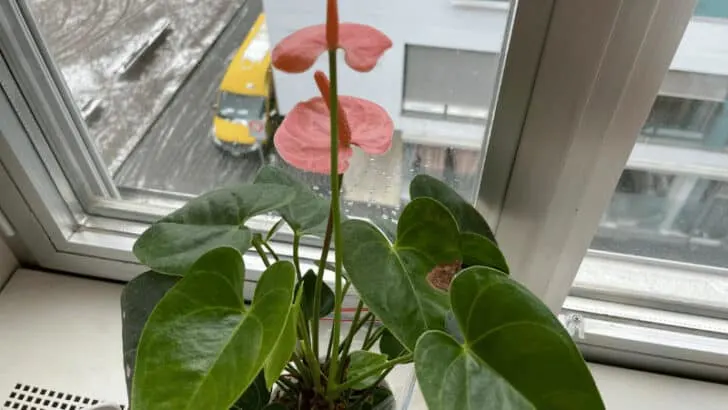Why is my Anthurium not flowering? Anthuriums bloom throughout the year. They produce beautiful flowers and are often used in flower arrangements.
They usually adhere to a three months flowering and three months, not flowering cycle. But somethings Flamingo flowers won’t bloom.
The University of Florida states that new cultivars of Anthurium flower earlier. They also produce more flowers.
The hybrids grow similar inflorescences. The size increases as the plants mature.
In this article, I am going through all the possible reasons I have witnessed when I couldn’t bring my anthurium to bloom.
Table of Contents
Anthurium Not Flowering
Anthuriums are not flowering because of incorrect lighting, not enough or too much fertilizer, and temperature and humidity stress. Major factors also play the watering schedule and the potting mix.
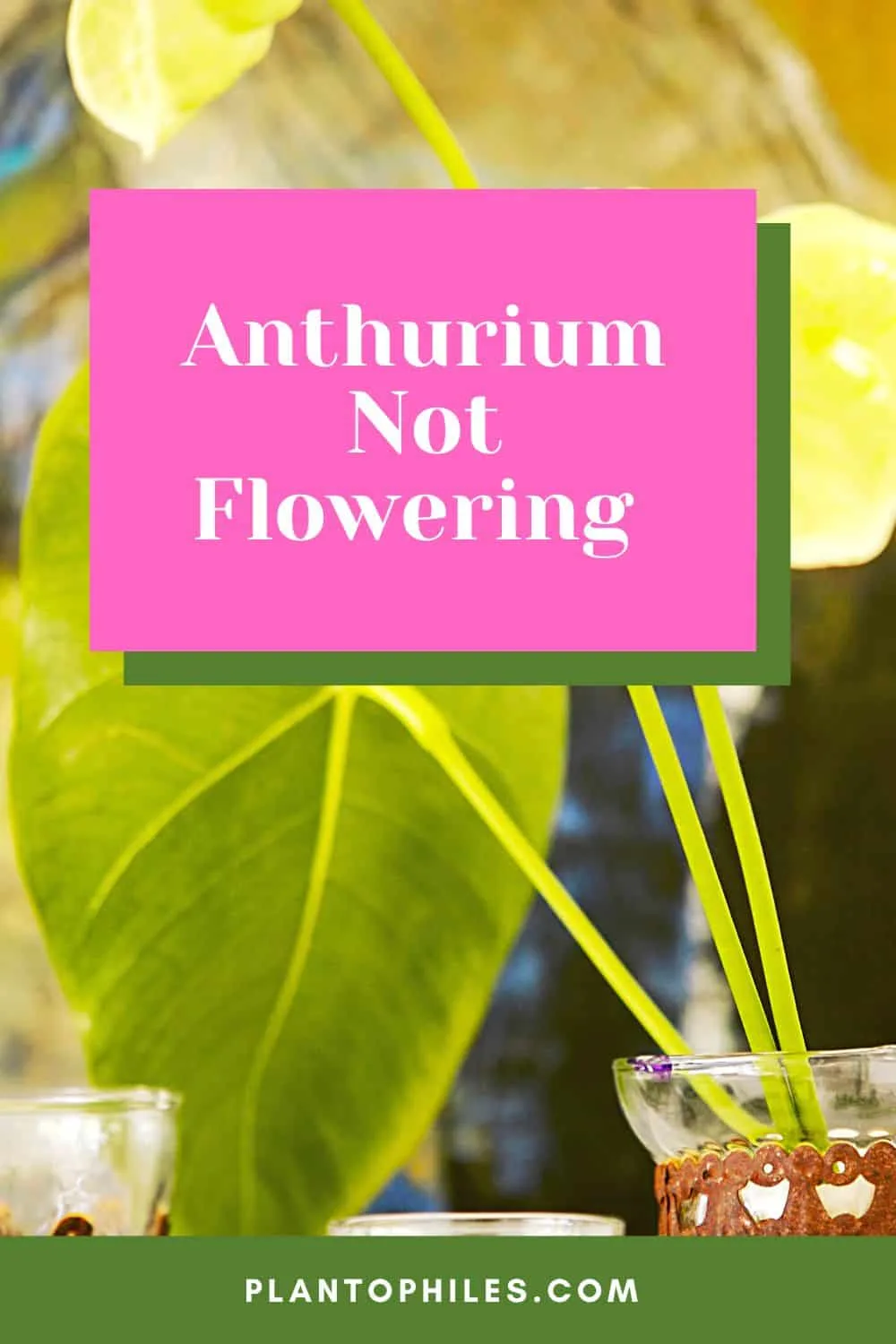
Anthurium Care Basics
The Painter’s Palette needs bright indirect light. 2-2.5k foot candles are optimal. The ideal potting mix is well-draining. A good choice is chunky aroid soil.
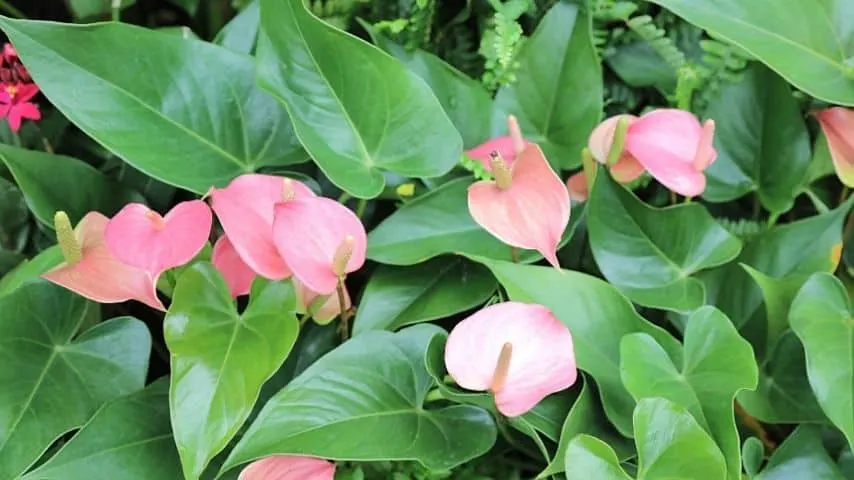
Use a pot with drainage holes. In addition, provide a temperature range between 77-92°F (25-32°C). The optimal humidity is between 70-80%.
Water your anthurium every seven days once the top 1-inch of soil is dry (2.5cm).
Fertilize monthly in the growing season in spring and summer. The ideal fertilizer is a balanced liquid fertilizer with an NPK of 10-10-10 or 20-20-20.
14 Reasons Why Anthurium is not Flowering — Get an Anthurium to Bloom
1. Soil
Dense soil won’t allow sufficient airflow to the roots. The plant’s roots need to be oxygenated.
This is only possible when air pockets can form in the potting soil. The result is the plant doesn’t flower.
Solution
Use a chunky mix consisting of peat, perlite, pumice, charcoal, and orchid bark. Without a well-draining potting mixture, indoor plants have difficulties growing.
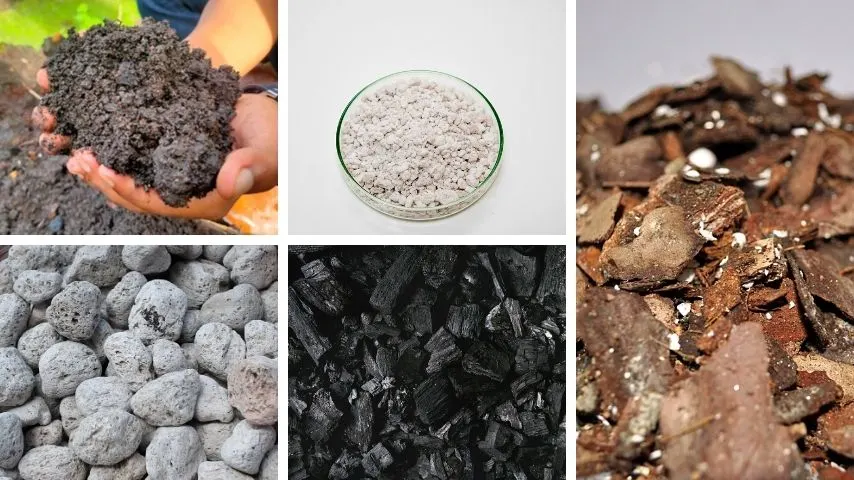
Anthuriums tend to do better in soil which allows the excess water to drain. Repot your Anthurium if this isn’t the case.
2. Watering
Water stress can prohibit a plant’s growth. Too little or too much has adverse effects. Too much water leads to soggy soil and, eventually, root rot.
Too little water leads to wilting leaves, flowers, and plants. Never water your Anthurium in the evening.
Solution
You should have a regular watering schedule. A good rule of thumb is about one every seven days. It can also be twice a week.
Water the potting mixture thoroughly. Water more in summer compared to winter. Adjust the watering based on the light, humidity, and temperature.
In addition, the size of the plant, the root mass, the pot, and the potting soil affect how much you have to water. Water when the soil dries out. Water the plant in the morning.
3. Lighting
Lighting is important. Plants need to conduct photosynthesis using chlorophyll.
Shade indoors is not advised. Your plants need a sunny location in an eastern- or western-facing window.
Avoid direct sunlight in the afternoon. Too much light might scorch and burn the leaves.
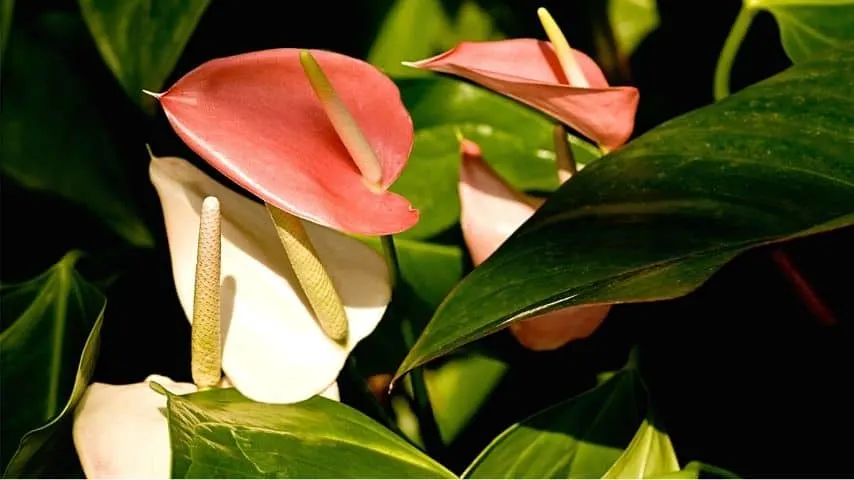
Anthuriums won’t bloom if you don’t give your plant enough light.
Solution
Provide bright light throughout the day. Use grow lights in case sufficient natural sunlight is not available. This is the best way to make sure new flowers are produced readily.
Ensure your Anthurium does not receive more than 4-6 hours of direct light. Preferably in the mornings. Anthuriums typically don’t do well in south-facing windows.
A study by Hawaii University proved increased flowering due to higher light levels.
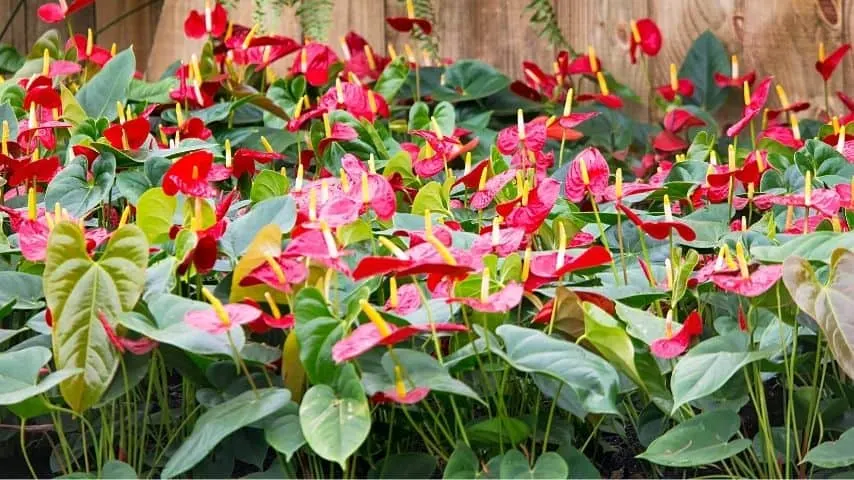
4. Temperature
Anthuriums grow best in temperatures between 77-92 degrees Fahrenheit (25-32 degrees Celsius).
Temperatures below 50 degrees Fahrenheit (15°C) or above 92 degrees (32°C) stress the plant. Cold drafts, as well as abrupt temperature changes, are also harmful.
Solution
To get an Anthurium houseplant to bloom, ensure it is in a location with constant temperatures. Don’t keep it too close to windows or heaters.
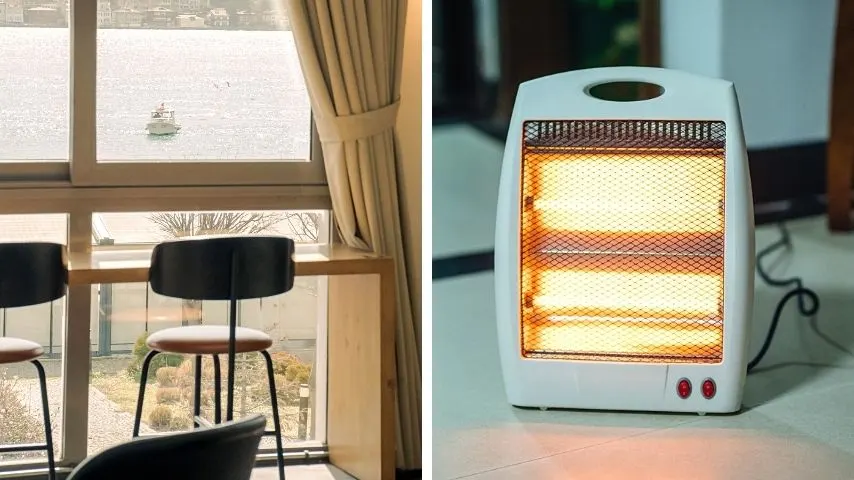
5. Humidity
An overlooked factor is humidity. When your Anthurium isn’t blooming, it could be because of low humidity.
These plants tolerate lower humidity, around 50-40%, but the growth rate is not ideal.
Solution
Getting your Anthurium to bloom requires that you mimic the tropical conditions in the jungle as much as possible. The range that these tropical plants prefer is 70-80%.
A humidifier, a terrarium, or a container can help you get these measurements. Alternatively, use a pebble tray filled with water underneath the pot.
Putting plants closely together also increases humidity.
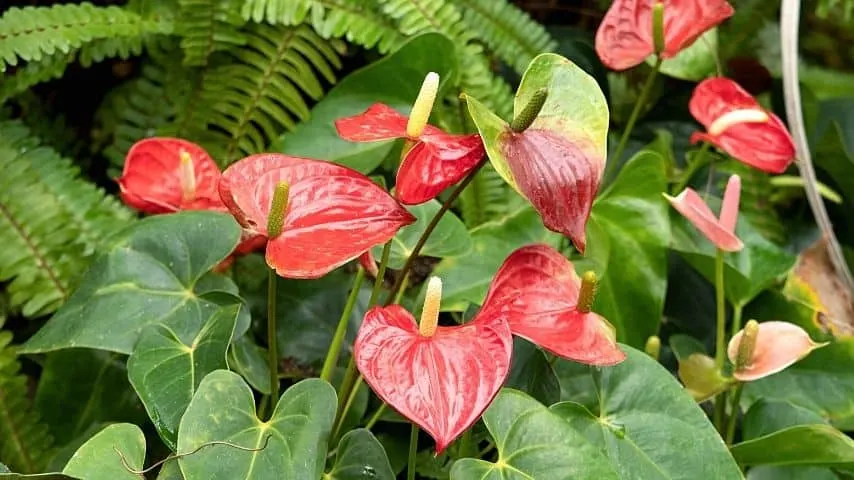
6. Air Circulation
Insufficient airflow can prevent your Anthurium from flowering. Without ample airflow, it is challenging to grow a healthy plant.
Anthuriums are generally more robust when allowed to move naturally. Plants require their foliage to dry quickly. If water drops remain on leaves or flowers for too long, they will rot.
The reason is bacteria and fungi that spread and grow. They swim across the water on the leaves.
Solution
Since there is no wind indoors, use a ventilator. Ensure your anthurium isn’t exposed to too much airflow, which could dry it out.
Anthuriums grow more flowers and stronger stems this way.
7. Fertilizer
Infrequent fertilization starves potted plants of nutrients. The amount of micro- and macronutrients in a pot with potting soil is limited. Tap water, as well as rainwater, contains little nutrients.
To bring the plant to flower, ensure that the potted Anthurium gets sufficient plant food. Flowering plants are hungrier than non-flowering plants.
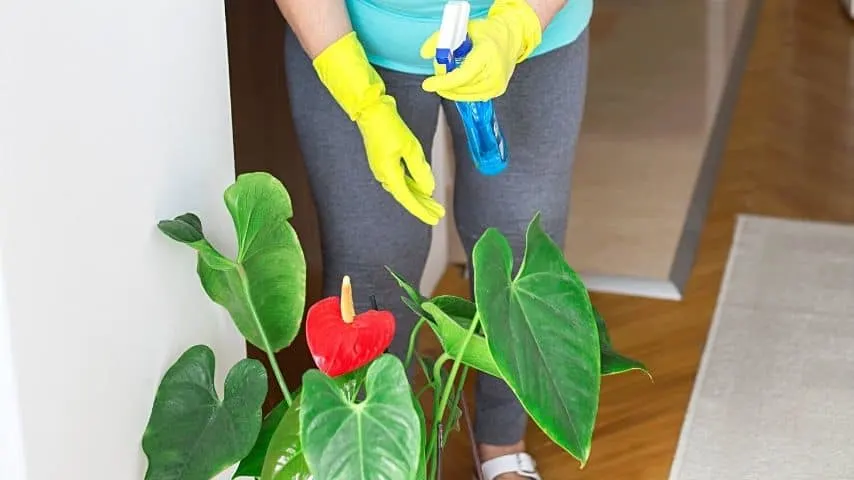
Solution
Use a well-balanced fertilizer rich in Nitrogen (N), Phosphorus (P), and Potassium (K). Fertilize monthly in spring and summer.
Replace your potting soil every two years. Alternatively, use a slow-release fertilizer every 3-6 months.
You can also fertilize your plans weekly weakly. For this, dilute the fertilizer to 1/2 or 1/3 of the recommended strength.
In a study by the University of Hawaii, monthly fertilizer significantly increased spathe size and flower production.
8. Pot
One of the reasons why your Anthurium is not blooming could be the pot. A terracotta pot is porous and might drain too much humidity from the soil.
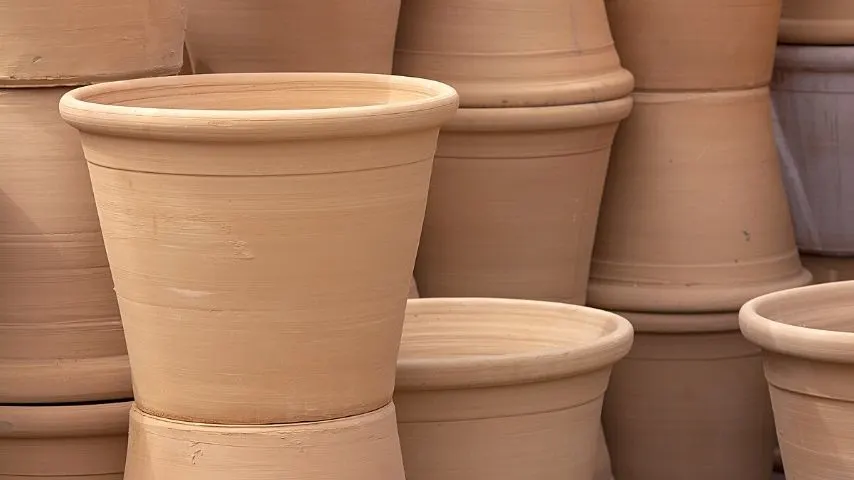
A plastic pot, on the other hand, does not breathe and release water.
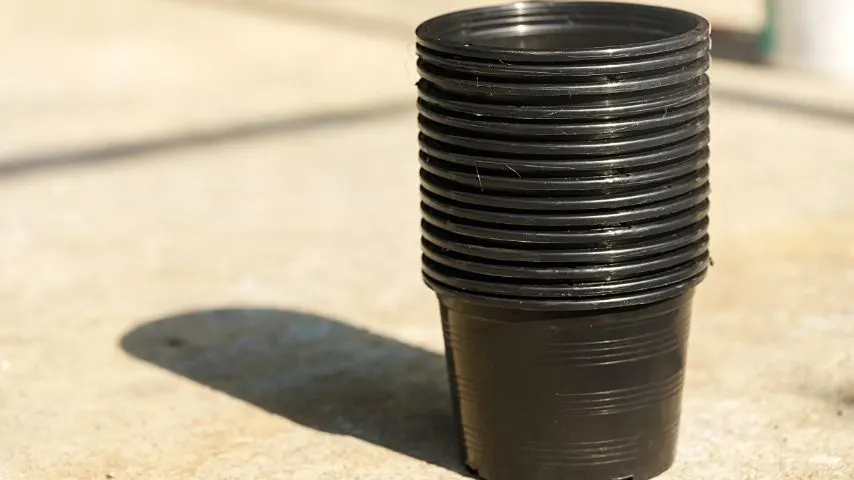
Potting holes at the bottom are essential so excess water can drain. Some cultivars flower better in smaller pots. A 4-inch to 6-inch pot might be sufficient.
Solution
If your plant isn’t flowering, inspect the pot. Does it hold exactly the humidity in the soil your plant needs? Is it too big or too small?
If the pot is not suitable, think about repotting your anthurium. Ensure that the combination of potting medium and pot allows for the soil to dry up quickly.
9. Repotting
There is a straightforward rule here. Never repot when your plant is either already in bloom or is about to bloom. Repotting can reset your plant. It can get an anthurium plant to abort flowers.
Another reason you cannot make it to bloom is when the plant is either root or pot-bound. It has already outgrown the pot but hasn’t been repotted yet.
Solution
When repotting a plant, always choose a pot that only is 1-2 sizes bigger than the plant, including the root ball.
If you want your plant to bloom, only repot in Spring and Summer. This is when plants are actively growing. They will recover quickly and start growing new roots and adapting.
Repot every 1-2 years, depending on the anthurium’s size and growth rate. Ensure there is always sufficient soil in the pot.
10. Pests
Pests like mealybugs, thrips, scales, whiteflies, and spider mites are sap-sucking bugs. They are often a vector for diseases such as thrips.
The worst thing is that they cost your plant energy and deprive it of nutrients. An infested plant is weak. You won’t make it bloom.
A paper by the University of Hawaii states that injuries caused by debris and pests hurt flowering.
Solution
Inspect your plants weekly for pests. Check the underside of the leaves.
Have a look at the soil. Look out for yellowing leaves as well as browning leaves.
Use neem oil or insecticidal soap. Use a spraying bottle and spray infected plants weekly.
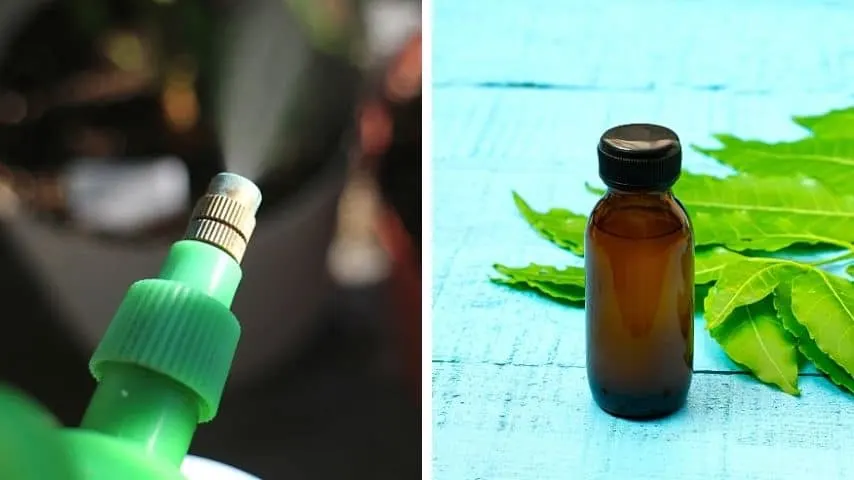
Apply rubbing alcohol to visible pests using a Q-tip. The alcohol on the cotton swab will dissolve the insects.
11. Diseases such as Bacteria and Fungus
Bacterial such as bacterial blight Xanthomonas can lead to spathe and spadix necrosis. It also leads to flower rejection by the plant.
The Department of Plant and Environmental Protection Sciences dedicated a research paper to the impact of Anthurium inflorescence injuries.
Solution
Closely inspect plants before you buy them. Only bring plants home free of diseases.
12. A Lack of Pruning
For consistent flowering, you need to ensure the Anthurium receives enough nutrients. It also needs to be pest-free to produce flowers.
It may be flowering despite being attacked by pests, but this will cost a lot of energy.
Solution
Look around your plant. Take note of dying flowers and foliage. By pruning off wilting and dying inflorescences, and leaves, you ensure fewer pests. Pests prefer to inhabit dying flowers and leaves.
A second benefit is that the plant doesn’t need any more energy to sustain dying flowers.
13. Not Propagating Your Plant
Plants do not live endlessly. Anthurium plants can grow for about five years indoors. Then they become old and tend to wilt and die.
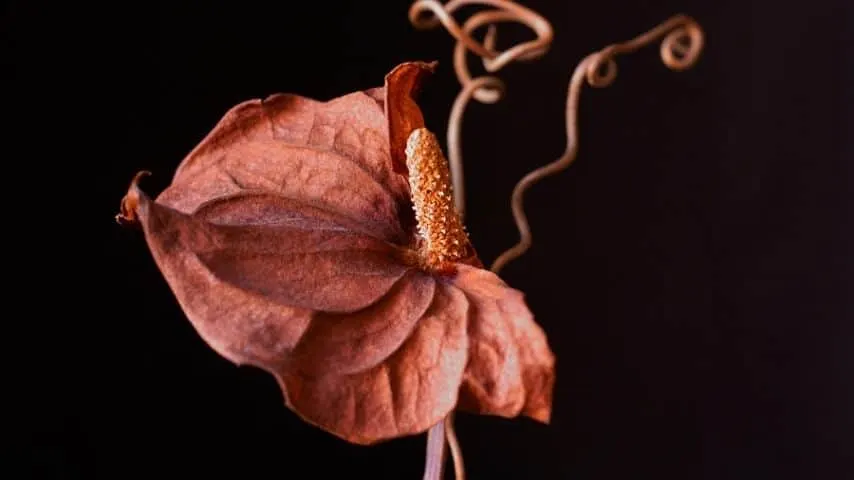
Mature Anthuriums generally produce more flowers. But once they get old, they lack vigor and energy. This is when giving your Anthurium a rejuvenation treatment is essential.
Solution
Propagate your Anthurium by separation. Dividing the roots mass and offshoots from the mother plant produces more clones.
In addition, your mother plant has more space and nutrients. Place the plantlets into separate containers.
14. Too much Salt Buildup
Salts build up from fertilizer usage. The more salt is found in the soil, plant roots will have difficulty taking in nutrients.
Solution
Flush the soil with clean water to remove excess salt buildup. You can use a hose or your shower.
When watering your plant, ensure the water passes through the pot’s drainage holes.
Anthurium andaeanum
The most common Anthurium is the Anthurium andraeanum. It is not difficult to grow. It produces beautiful flowers consisting of red, white, and yellow spathes.
They are aroid plants. They have a spathe and a spadix. Anthuriums are known epiphytes as they grow on other plants and objects.
The Araceae family consists of 144 genera and 3645 published species, according to Research Gate.
The Anthurium Flower
An Anthurium flower consists of a spathe and spadix. The spathe is a modified glossy leaf.
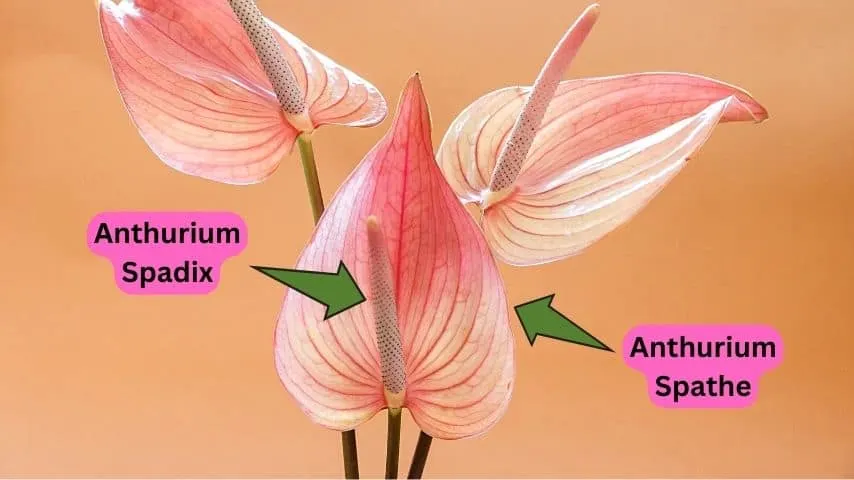
The colors can be red, pink, white, or yellow. The spadix grows at the center. It looks like a stick.
The flowers themselves grow as tiny flower clusters on the spadix.
Frequently Asked Questions about Anthurium Not Flowering
How often does an anthurium bloom?
Anthurium plants can bloom throughout the year. They usually bloom for three months and the rest for three months. The alternate between these two states.
Will an anthurium bloom again?
Anthurium plants do rebloom. They bloom multiple times a year.
How can you get an Anthurium to produce more flowers?
To produce more flowers, fertilize your plant monthly using well-balanced liquid fertilizers. The more mature a plant is, the more flowers it will grow.

Daniel has been a plant enthusiast for over 20 years. He owns hundreds of houseplants and prepares for the chili growing seasons yearly with great anticipation. His favorite plants are plant species in the Araceae family, such as Monstera, Philodendron, and Anthurium. He also loves gardening and is growing hot peppers, tomatoes, and many more vegetables.

